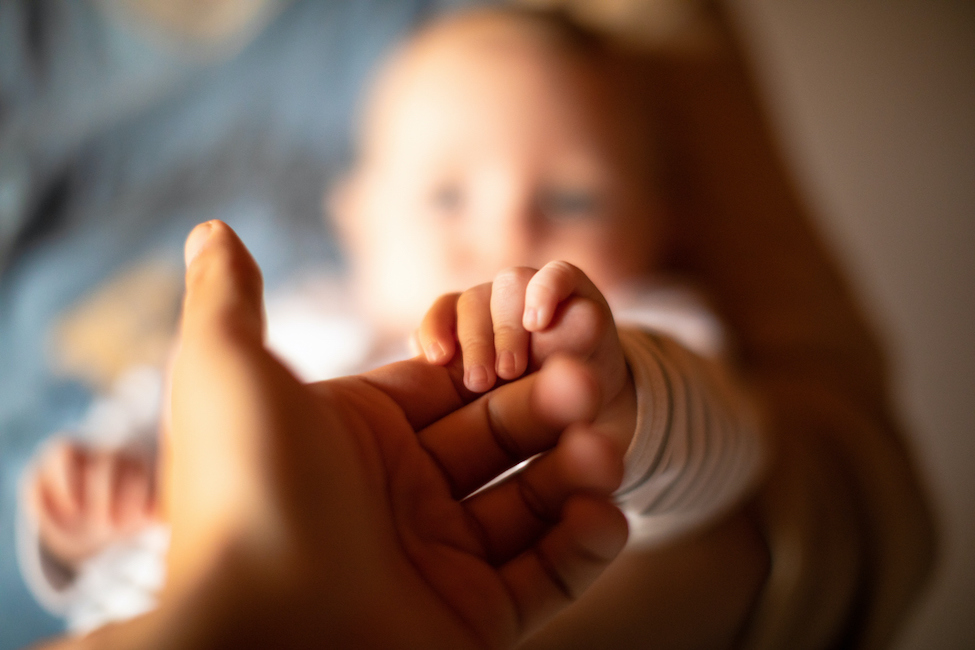Table of Contents
Im taking a natural birthing course at the moment. Nine weeks of once-weekly evening classes, Sundays or Tuesdays, your choice. Fifteen of us sit in our living rooms in front of Zoom screens, intently listening, confidently (or questioningly) answering when called on, and taking notes of all the green and red flags, and, well, of what to actually expect when you’re more than expecting.
We add our handwritten notes to three-ring, ~150-page course binders that cover everything from nutrition to labor, and breastfeeding to baby care.
In 3 to 6 months, each of us will be giving birth. In a hospital, at a birthing center, or at home. Amid a declared pandemic.
We’re watching a friendly, personable, animated teacher. Licensed in 1981, she’s been doing this—childbirth and lactation education—for nearly 40 years. Spent 14 years as a doula and labor coach. 5,000 couples have come before us and graduated the class.
Most of these book suggestions are her hand-picked titles on the best in natural birthing, listed in resources freely available to paying students and non-paying perusers alike. Between classes, I’ve been reading. And highlighting. And taking even more notes.

01. Gentle Birth, Gentle Mothering
A Doctor’s Guide to Natural Childbirth and Gentle Early Parenting Choices — Sarah J. Buckley, M.D. • 352 pages • 2009
If you read just one book on the list, make it this one. Written by Sarah J. Buckley, MD, this “Doctor’s Guide to Natural Childbirth and Gentle Early Parenting Choices” is a gold mine of information.
Compelling, intriguing, beautifully formatted, and info-packed, this book could be your one complete guide and go-to for the entire experience.
Chapters include, “Your Body, Your Baby, Your Choice: A Guide to Making Wise Decisions,” “Ultrasound Scans: Cause for Concern,” “Epidurals: Risks and Concerns for Mothers and Babies,” “Cesarean Surgery: The Whole Story” and, “Babies, Mothers, and the Science of Sharing Sleep.”
In the book’s foreword, Ina May Gaskin says it best: “Here’s what makes Sarah Buckley’s writing so authoritative and compelling. She knows medicine because of her years of medical training and experience. But unlike 99 percent of her medical colleagues in the wealthy countries, she also knows unmedicated birth in a way that only one who has experienced it can—by giving birth at home four times.” (And if birthing at home isn’t what you’ll opt for, birthing centers and hospitals are also very well covered, too.)
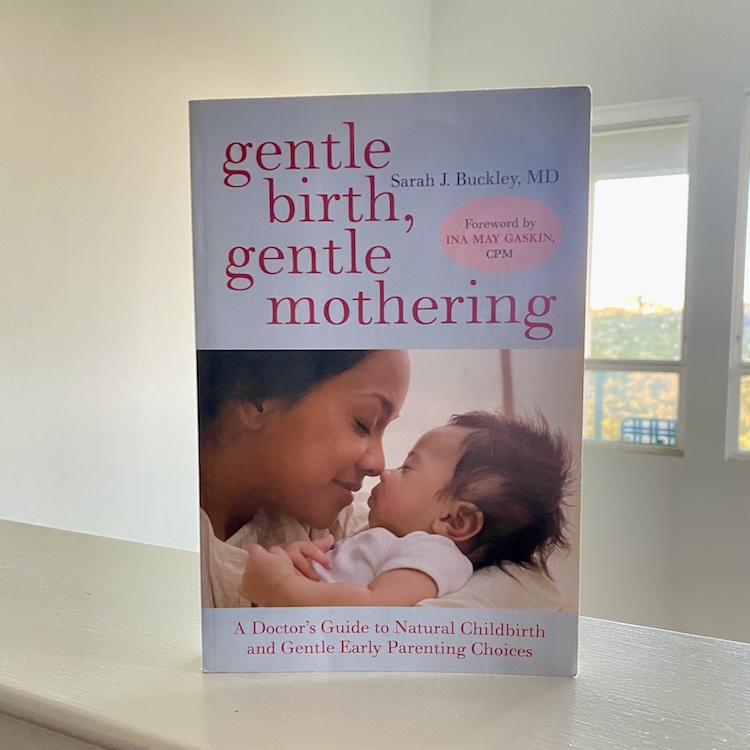
For the Hour Following Birth:
- “Don’t separate mother and baby for any reason…
- “Keep lighting low, and the room very warm, beginning just before birth
- “Maintain an atmosphere of quiet and calm for mother and baby.
- “Facilitate immediate and uninterrupted skin-to-skin contact between mother and baby. Weighing, measuring, bathing, and washing are unnecessary at this time.
- “Support breastfeeding soon after birth, ideally allowing the baby to find the nipple and self-attach without disturbance.”
“How can we avoid disturbing the process of birth and align our practices with our evolutionary blueprint? This can seem difficult in a culture in which birth has been disturbed, one way or another, for many generations. Yet it is really very simple. If we were to provide conditions of privacy, and a sense of safety for birth—which, as the late Jeannine Parvati Baker reminds us, ‘is orgasmic in its essence’—most women would experience a spontaneous, ecstatic, and relatively easy birth.” | Sarah J. Buckley, MD, Gentle Birth, Gentle Mothering
02. Natural Hospital Birth
The Best of Both Worlds — Cynthia Gabriel • 272 pages • 2018 (Fully updated 2nd Ed)
- Part 1: Preparing for Your Baby’s Birth
- Part 2: Giving Birth
- Part 3: Putting It All Together
Written by certified doula Cynthia Gabriel, this guide to consciously preparing for exactly the kind of birthing experience mothers would prefer is non-judgemental and reads like wise advice from someone who knows exactly how you’re feeling.
Gabriel is a mom of three herself, but never comes across as patronizing or condescending. Instead, she gives readers the facts without scaremongering.
Crucially for many expectant moms, she isn’t anti-hospital, either. Instead, she explains how a natural birth with minimal intervention can still be achieved within the comforting setting of a hospital.
Through anecdotal examples, straightforward language, and thought-provoking questions, this book informs you of your options and helps you make the best choices, from Preparing For Your Baby’s Birth, to Giving Birth, and Putting It All Together.
What Is a Natural Birth?
“Natural birth is defined differently by different people. Natural birth can refer to any of the following, alone or in combination:
- Vaginal birth, with or without the use of pharmaceutical drugs
- Birth without pain-relieving drugs
- Birth without any drugs whatsoever
- Birth with only select interventions allowed, according to the mother’s birth plan
- Birth with the fewest interventions possible to support the health of the mother and baby
“In this book, natural birth means the most instinctive, self-directed, intervention-free birth possible.” | Cynthia Gabriel, Natural Hospital Birth: The Best of Both Worlds
02A. The Expectant Father (The Ultimate Guide for Dads-to-Be)
You can browse parenting sites like Fatherly and That Dad Blog for hours to get “a good idea” of “what it’ll be like” to be a father. But the benefits of a book for expectant fathers is that a good author (if you get the right book), who himself is a father and made all the mistakes and yet lived to share their solutions, has invested the hundreds of hours into chaptering out and writing on all of the important things you need to know about parenting: there’s a beginning and an end to it—a front and back cover—and when you’re about to become a parent, there’s just something comforting about knowing at least as much as that you’re up to date on the expected skills and knowledge.
The Expectant Father packages it all nicely, is well organized, formatted, and indexed, and has a killer cover that looks great on the coffee table. Just be sure yours is dog-eared and well-worn so it looks like you’ve actually read it. And, seriously, you should.
The Expectant Father isn’t exactly a “natural” parenting book like the others on this list, (though the concept is briefly covered, as are a number of parenting possibilities, like c-sections, and adoption), and the chapter on “Money. Money, Money” says less about how much money you’ll need in the short term and to actually have that baby, but all things considered, this is must-read for any future father-to-be.
03. The Birth Partner Handbook
Everything You Need to Know for a Healthy, Positive Birth Experience — Carl Jones • 240 pages • 2010
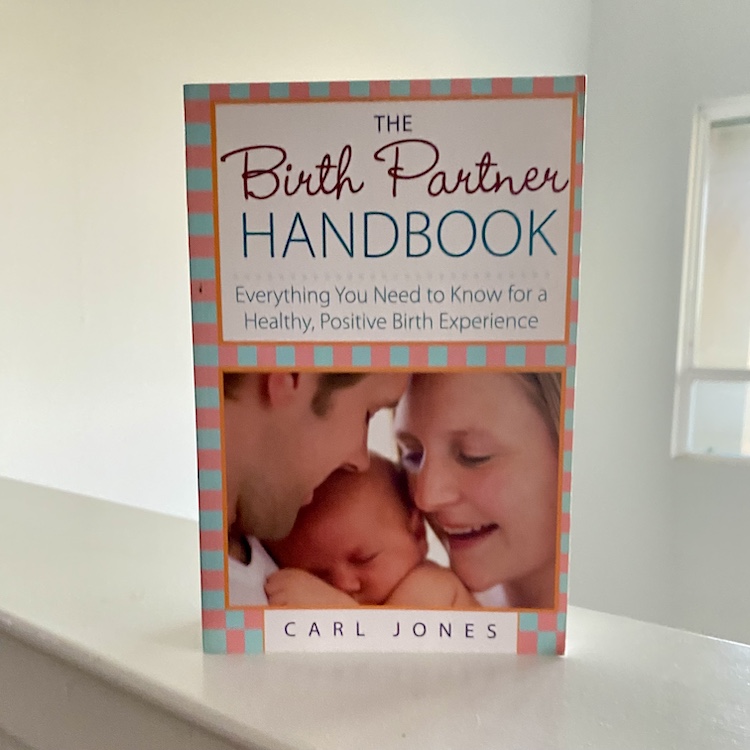
While nobody other than a mom can really appreciate the physical aspects of pregnancy and birth, for those who support her through the process it can be a difficult time, too.
Carl Jones has recognized the need to deliver a book that gives husbands, wives, and other birthing partners advice on both what to expect and how to best to be supportive and understanding.
It’s the kind of book wives are thrusting into the hands of their husbands and begging them to read, as Jones explains the hormonal changes and resulting mental states women find themselves in, better than many women could explain themselves.
By equipping birthing partners, Carl Jones is by extension supporting moms in whichever setting they choose to give birth.
Helping Her Every Step of the Way: Birth (Second-Stage Labor)
- “Help her change position…
- “Help her relax between contractions…
- “Help her to relax her pelvic floor…
- “Interface with the obstetrical staff…
- “Encourage her to imagine herself opening for the baby…
- “Let her know when you first glimpse the baby’s head…
- “Remind her to reach down and touch the baby’s head…
- “Hold a mirror so she can watch the birth…
- “When the head crowns, assist her to breathe the baby out…
- “Try to minimize the last-minute commotion…
- “Help her avoid tearing…
- “Help her avoid an episiotomy…”
“Enjoy the birth process as you help your partner. This is the most exciting and dramatic part of labor. Everyone gets involved. But don’t forget to help her during all the excitement.” | Carl Jones, The Birth Partner Handbook
04. The Complete Book of Pregnancy & Childbirth
Sheila Kitzinger • 448 pages • 2003
Considered by many to be the pioneer of natural birthing and a woman who reclaimed control of birth for women all over the world, Sheila Kitzinger’s book is a classic.
It’s the Complete Book of Pregnancy and Childbirth and you’d be hard pressed to find a question about the topic that isn’t covered in this guide.
From cesareans to multiple births, epidurals to umbilical cords, Kitzinger leaves no stone unturned. It’s seen many a mom through labor and continues to do so in the years since the author herself (an experienced mom of five daughters) passed.
Doulas recommend it, moms refer to it for not just their first but subsequent births, and birthing partners find it invaluable. It’s a book for all involved in the pregnancy process.\
05. The Birth Partner
A Complete Guide to Childbirth for Dads, Partners, Doulas, and All Other Labor Companions — Penny Simkin • 440 pages • 2018
Simkin isn’t so much concerned with the earlier part of pregnancy, but instead jumps straight into the third trimester, particularly for when labor begins. She explores both medicinal and natural ways to get labor going and easing pain once it’s underway.
It’s helpful for moms looking to have a natural birth as it prepares expectant mothers for every step of labor by walking them through what’s happening to their bodies, but it’s also invaluable for birthing partners, too. Dads and birthing partners will find the advice just as helpful.
06. The Thinking Woman’s Guide to a Better Birth
Henci Goer • 384 pages • 1999
This is the kind of book we were talking about when we mentioned women having the ability to make informed choices when it comes to their birthing plan.
After all, you can’t make an informed choice without the information, and this book by Henci Geer gives it to moms in abundance.
The latest edition is up to date with the latest medical procedures and scientific evidence, so that you can rest assured you’re reading a book that abolishes myth and gives you the facts you need to create the birth plan you want.
Even if you’re not even pregnant yet, you’ll find Goer’s informed and experienced advice both comforting and empowering. She’s a champion for women who want to stay in control of their own natural birthing plan, but who are also prepared for every eventuality.
07. Mind Over Labor: A Breakthrough Guide to Giving Birth
Carl Jones • 192 pages • 1988
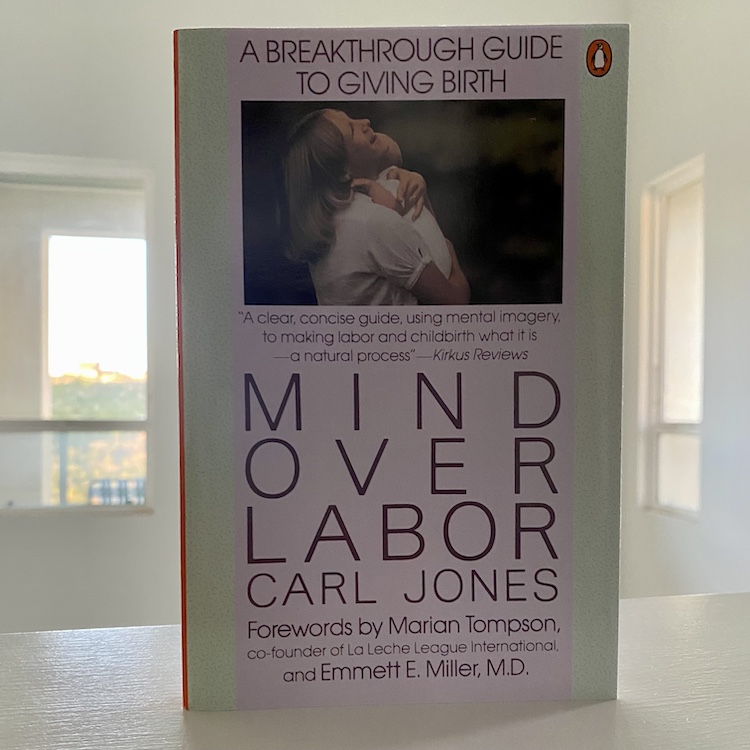
Millions of women in America swear by Carl Jones’s tips and advice for overcoming the feeling of helplessness some experience when giving birth.
He doesn’t sugar-coat the reality of labor (yes, it’s painful) but suggests meditations, as opposed to medications, that can help you stay in control of your labor by eliminating the fear of the process before it even begins. This is one to read before the third trimester, so you feel completely prepared.
Since most of these titles are recommended by a birthing class, and because Mind Over Labor covers more than state of mind, here’s an excerpt from it on how to choose a childbirth class:
Choosing a Childbirth Class
“The best classes are small (ten couples or fewer) and usually take place in a supportive, nonclinical atmosphere, often private homes, where you are free to raise questions and discuss your feelings.
“Here are some points you should bear in mind when choosing a class: Classes should:
- Meet your individual needs.
- Be held on ‘neutral ground,’ not in the same institution where you plan to birth. Though there are certainly many exceptions, hospital classes often reflect the view of the particular institution in which they are taught. Many merely inform expectant parents of policies and aim to create compliant patients rather than give an objective view of available options.
- Present home, childbearing-center, and hospital birth on an equal footing.
- Teach something about cesarean prevention, not just about cesarean birth.
“Be sure your instructor supports natural childbirth—and not in name only! One way to tell if a childbirth educator supports natural birth is to ask what she recommends to avoid tearing or an episiotomy, what guidelines she offers for children who may be present at birth, and what she teaches about home birth. A true proponent of natural childbirth should cover all these subjects in a positive light.” | Carl Jones, Mind Over Labor
08. Ina May’s Guide to Childbirth
Ina May • 400 pages • 2003
If you find a male author with even the best of intentions giving advice on childbirth a little too difficult to reconcile with, try a book by the leading midwife in the country, instead.
In Ina May Gaskin’s classic Guide to Childbirth, you’re taken back to the ancient wisdom of the mothers and grandmothers of old, who trusted their bodies to do as nature intended and guide them through the whole process.
It really focuses on channeling that connection we have with our bodies, and it’s particularly helpful for women who’ve never felt that connected to their inner selves. It empowers as it educates, encourages as it explains.
09. The Birth Book
Everything You Need to Know to Have a Safe and Satisfying Birth — William Sears, M.D. & Martha Sears RN • 280 pages • 1994
Ultimately, women want a safe and satisfying birth, so this book comes highly recommended because it covers the how-to on just that.
Written by husband-and-wife pediatric team Martha and Bill Sears (you may know them as the nurse and doctor who together coined the term “attachment parenting), this book is a staple of natural childbirth.
Because they both work in the medical profession, the Sears aren’t trying to move you away from medical help during birth. What they encourage is as natural a birth as possible, which is hugely satisfying, but making it safe by taking the right precautions when necessary.
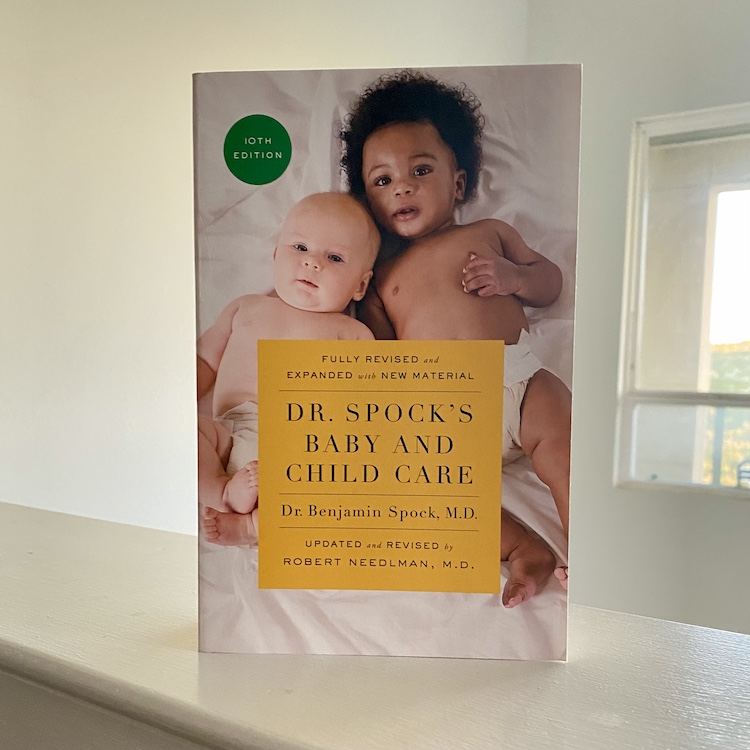

10. The Healthy Pregnancy Book
Month by Month, Everything You Need to Know from America’s Baby Experts — William Sears, M.D. & Martha Sears RN • 464 pages • 2013
We’re back with Martha and Bill Sears for this book, too, which has all the wisdom of the one above but is updated for a more modern audience.
This book looks at physical and mental health throughout pregnancy, not just birth, suggesting healthy eating tips, superfood recipes, and staying fit.
There’s also a section on genetic counselling, which is something our moms wouldn’t have had much advice on when we were born, so there’s a much more contemporary slant on the advice this book contains.
It’s not challenging or condescending, so you can dip in and out at your leisure and is great for using as a reference book for all pregnancy-related health issues, from getting healthy before conceiving, to staying healthy after birth.


